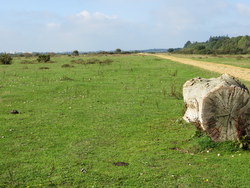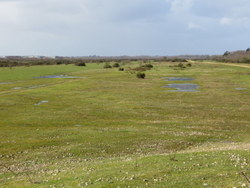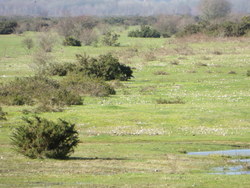Compartment 9 is the northeastern one of four parcels (commonly called "lozenges") bordered by the former runway and taxiways. The lozenges form four similarly sized, long linear sections, all of which are very rich in flora, containing national and Berkshire rarities.
General description and evaluation of ecology
Compartment 9 supports a complex of large tracts of dry heath with heather, dwarf gorse and fragments of lichen heath, acid grassland and fairly extensive strips of gorse scrub. Typical species of the acid grassland include mouse-ear hawkweed, heath milkwort, narrow-leaved vetch and heath grass. More rarely in open dry swards, early hair grass, tormentil and the nationally scarce annual knawel and upright chickweed can be found. Bare gravels have abundant rue-leaved saxifrage in some areas and the short, damp grassland often supports blinks.
The grassland on the edges is somewhat neutral in character, probably as a result of spray and wash from the concrete runway (now removed) and other structures. Typical species here are common knapweed, mouse-ear hawkweed, common sorrel, red clover and bird's foot trefoil along with more localised species like autumn ladies tresses, green winged orchid and great burnet, all uncommon in Berkshire. Damper grassland dipping slightly in the centre of the compartment is dominated by rushes, sedges and contains devil's bit scabious and cuckooflower.
BAP habitats
- Lowland heathland
- Lowland dry acid grassland
- Lowland meadow
Higher Level Stewardship
Options exist for this compartment.
- HO1 (maintenance of lowland heathland)
- HK6 (maintenance of species-rich, semi-natural grassland)
- HR2 (supplement for native breeds at risk)
Overall management objectives
The main management here will be scrub control, predominantly to reduce any further expansion of gorse into species-rich areas of grassland and heathland, while maintaining a diversely structured mosaic in the stands of heather, gorse and dwarf gorse.
Compartment 9 (19.4 ha)



| Objective | Area | Method | Comment |
|---|---|---|---|
| 9.1) Maintain and where possible, expand the areas of existing heathland and acid and neutral grassland mosaic into areas dominated by gorse or species-poor grassland. | Across compartment. | Suitable areas of gorse can be cut, the arisings removed and the ground scraped to remove litter. Allow space to re-generate naturally.
Species-poor areas can have very small scrapes made within them to create bare gravel areas. Control ragwort. |
Refer to Gorse Management Plan (WBC 2012). |
9.2) Diversify heathland structure.HLS objectives |
Across compartment. | Grazing is the primary tool. Monitoring of the grassland sward and control of grazing is a vital part of this management.
Mow and scrape small sections of the heathland each year to maintain a diverse structure. Cuttings can be used for regeneration elsewhere. Control ragwort. |
Refer to Gorse Management Plan (WBC 2012).. Investigation is ongoing into the invasive liverwort mentioned in the Bryophyte and Lichen Site Dossier (NatureBureau 2009). |